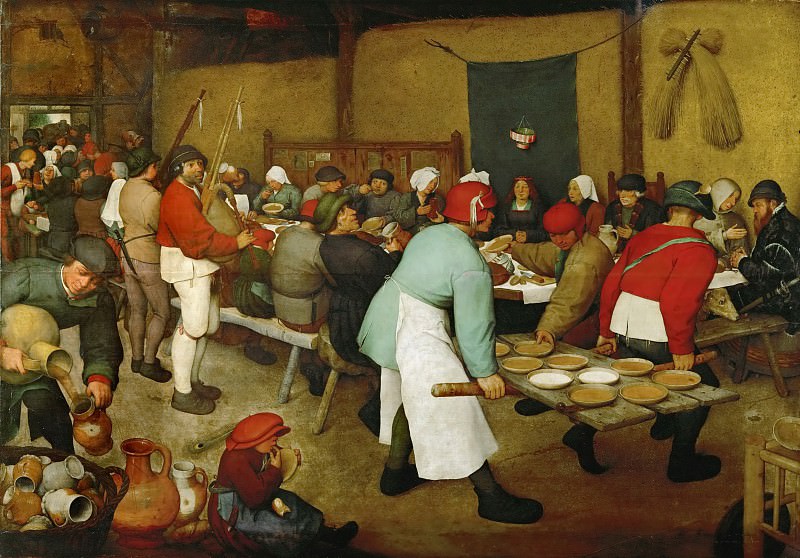Peasant Wedding Pieter Brueghel The Elder (1525-1569)
Pieter Brueghel The Elder – Peasant Wedding
Edit attribution
Download full size: 3910×2727 px (4,1 Mb)
Painter: Pieter Brueghel The Elder
Location: Museum of Art History, Vienna (Kunsthistorisches Museum).
The great European artist of the Northern Renaissance, Peter Bruegel worked in France, Brussels, and Antwerp. All the subjects of his paintings were radically outside the classical iconography. Rather, they can be attributed to the satirical-allegorical type of art. The original painting "Peasant Wedding" is painted in oil on an oak plank. Like the bulk of his work, the canvas was donated to the Museum of Historical Art, Vienna. He always perceived life and the processes taking place as something strange and bizarre, perceived in his own vision and specific understanding of the world around him.
Description of Peter Brueghel’s painting A Peasant Wedding
The great European artist of the Northern Renaissance, Peter Bruegel worked in France, Brussels, and Antwerp. All the subjects of his paintings were radically outside the classical iconography. Rather, they can be attributed to the satirical-allegorical type of art.
The original painting "Peasant Wedding" is painted in oil on an oak plank. Like the bulk of his work, the canvas was donated to the Museum of Historical Art, Vienna.
He always perceived life and the processes taking place as something strange and bizarre, perceived in his own vision and specific understanding of the world around him. This manifested itself not only to his personal existence, but to all people in general, whom he was in the habit of observing. Having a great sense of humor, he sang in his works and one might say made fun of situations with all his natural spontaneity.
This is reflected in the image presented, where a seemingly joyful event takes place. However, all of the gathered people have absolute indifference in their eyes, and none of them smiles.
The young bride, all alone, sits sad and motionless. There are some people walking around everywhere, the invitees are sitting, drinking and eating, paying no attention to anyone. A man on the left is filling a jug of wine, while on the other side is carrying tortillas on a hinged door, using it instead of a tray.
All around them are eagerly staring at the delicacies.
Nearby, on the left, a child is sitting on the floor with a flatbread in his hands and eating it. He is wearing a funny hat with margins that partially covers his face and eyes.
Bruegel had the ability to emphasize the rudeness and down-to-earth nature of the peasants in everything. The drunken and clumsy characters of the painting, completely filled the lively scenes on his canvases, which is the clear opposite of the Italian canon of a refined style of depicting people.
Кому понравилось
Пожалуйста, подождите
На эту операцию может потребоваться несколько секунд.
Информация появится в новом окне,
если открытие новых окон не запрещено в настройках вашего браузера.
You need to login
Для работы с коллекциями – пожалуйста, войдите в аккаунт (open in new window).




















You cannot comment Why?
In Pieter Bruegel the Elders Peasant Wedding, the scene is set in a rustic barn filled with a lively crowd of peasants engaged in a wedding feast. The painting is characterized by its rich detail and realistic depiction of rural life.
What I see:
Subtexts:
In essence, Peasant Wedding is not just a depiction of an event, but a rich tapestry of peasant life, community, and celebration, rendered with Bruegels signature realism and keen observation of human behavior.